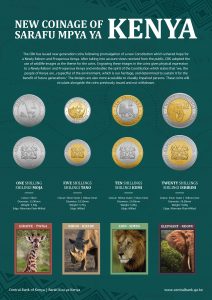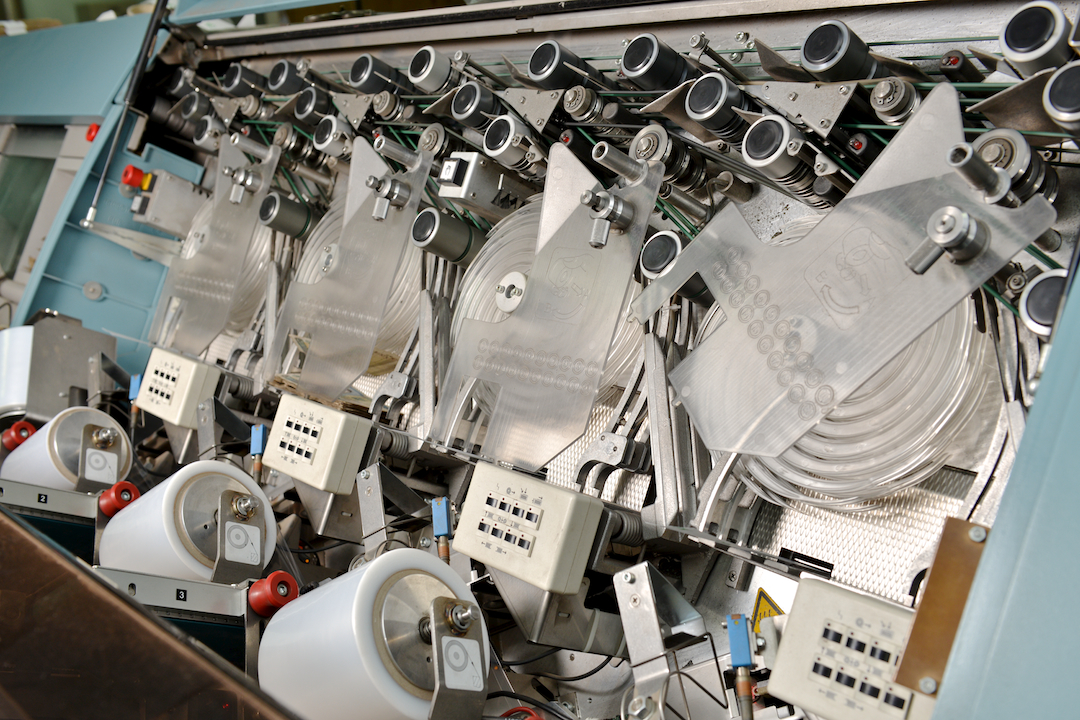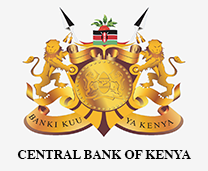Currency Services
Notes and Coins overview
The Central Bank of Kenya is the only institution in Kenya with full discretion and sole rights to issue currency notes and coins. The mandate is enshrined in Article 231 (2) of Kenya’s Constitution and the Central Bank of Kenya Act, Section 4 A (1) f. This mandate involves the following responsibilities:
• Planning, forecasting, procuring and distributing currency notes and coins.
• Setting up suitable currency distribution mechanisms.
• Safeguarding the integrity of Kenyan currency as a medium of exchange.
• Developing policies for proper handling.
Bank’s Role in Currency Management
It is the Bank’s objective to have only good quality currency circulation and this is achieved by setting quality standards for currency in circulation. The current standards were issued on July 14, 2008, under the Amended Banking Circular Number 4 of 2008. These standards predominantly guide commercial banks and other bulk cash handling bodies on how to sort currency.
The Bank designs its currencies with stakeholder engagements forming a critical part of the process. These engagements result in identifying concepts that depict the country and will be used in the currencies to be issued. On finalisation of the designs, the Bank procures its currencies in compliance with the Public Procurement Act.
Currency in Circulation
The Central Bank of Kenya began printing Kenyan banknotes in 1966 under the mandate given in the Central Bank of Kenya Act cap 491. The initial issue of Kenya shilling notes were in the denominations of 5, 10, 20, 50 and 100 shillings, all bearing the portrait of the First President of Kenya, H.E. Mzee Jomo Kenyatta on the front, and diverse scenes of economic activities in Kenya on the back.
Various other currencies have since been issued to circulation. The current generation of Kenyan banknotes range from denominations 50, 100, 200, 500 and 1,000 shillings while that of coins range from 50 cents, 1, 5, 10, 20 and 40 shillings. In December 2018 and June 2019, coins and banknotes with new security features to meet the 2010 Constitutional requirements were issued respectively.
Counterfeit Detection
Counterfeits are a threat to the circulation of genuine Kenyan currency. Security features in currency notes act as a deterrent and safeguard to minimize the risk of counterfeiting. We encourage the public to be aware of the available security features incorporated in genuine currency notes and coins, and to be able to distinguish between genuine and fake currency. Each genuine banknote incorporates a number of security features that make the counterfeiting of the currency notes extremely difficult. The following are public security features to be checked on the banknotes.
 |
 |

Currency Operations
Commercial banks regularly make deposits of bank notes and coins to their accounts in the Central Bank, where they are processed and sorted. The Central Bank maintains specialised machines that are used to process banknotes and coins, and those that are fit for circulation are set aside for re-distribution.
In its role of issuing currency, the Central Bank must also ensure that currency is distributed throughout the country. To accomplish this, the Central Bank has Branches in Mombasa, Kisumu and Eldoret and Centres in Nyeri, Nakuru, Meru and Kisii. These Branches and Centres form a key focal point for currency distribution to the local financial institutions.
Damaged Currency
Currency is considered damaged or unfit when it is mutilated, torn or marked with ink. It is typically removed from circulation when it is brought into the Central Bank, through deposits from commercial banks, and sorted out from fit currency. However, members of the general public who find damaged currency can also bring it to commercial banks or to the Central Bank offices and have it replaced, on condition that the following requirements are met:
- They have not been deliberately mutilated
- The currency must be genuine
- The currency must be more than half and continuous
- The banknote should bear at least one complete serial number
Damaged Notes and Coins
• Not deliberately mutilated
• Currency must be genuine
• More than half and continuous
• Bear at least one complete serial number
In case of coins, the inner part of coin for coins with outer bordering rings i.e. 10/=, 20/= and 40/=.
The Bank is not obliged to exchange any damaged currency. Any banknotes and coins presented for exchange will be carefully examined by the Bank. The Bank may seek to know from the presenter how the notes and coins were damaged.
No counterfeit currency will be exchanged for any value whatsoever.
The Central Bank issues commemorative currency to mark national or Central Bank occasions and anniversaries. These currencies are availed for sale at the Bank when in stock.
To purchase commemorative coins, please download the Commemorative Coin Order Form here and contact the Central Bank head office at comms@centralbank.go.ke or your nearest Central Bank Branch or Currency Centre.
Laws Related to Currency
The Central Bank of Kenya is the only body in Kenya with the specific mandate of issuing currency notes and coins. This mandate is enshrined in Article 231 (2) of Kenya’s Constitution and the Central Bank of Kenya Act Cap 491 Section 4 A (1) f. The Act also sets out other provisions in relation to Kenyan currency. The Penal Code Cap 63 Chapter XXXVI has specific provisions in reference to offenses relating to coin and banknote currency.
Constitution of Kenya
231 (2) The Central Bank of Kenya shall be responsible for formulating monetary policy, promoting price stability, issuing currency and performing other functions conferred on it by an Act of Parliament.
231 (4) Notes and coins issued by the Central Bank of Kenya may bear images that depict or symbolise Kenya or an aspect of Kenya but shall not bear the portrait of any individual.
CBK Act CAP 491
Section 4 A (1) f of the Central Bank of Kenya Act mandates the Bank to issue currency notes and coins.
Sec. 22 (1) The Bank shall have the sole right to issue notes and coins in Kenya and, subject to subsection (4), only those notes and coins shall be legal tender in Kenya: Provided that coins of a denomination of fifty cents shall be legal tender only for payments up to twenty shillings, and coins of a denomination of less than fifty cents shall be legal tender only for payments up to five shillings.
Sec. 22 (3) The Bank shall have power to withdraw any notes or coins issued by the Bank, and the procedure for and effect of withdrawal shall be as follows:
(a) a notice published in the Gazette, and in such other manner as the Bank considers likely to bring that notice to the attention of the public, shall specify the issues, and the denominations forming part of the issues, of notes or coins that are to be withdrawn, the places where those notes or coins may be taken for exchange, and the date on which those notes or coins shall cease to be legal tender;
(b) the notice given under paragraph (a) may provide that, after such period as may be specified in the notice, the notes or coins to which the notice applies shall only be exchanged at the head office of the Bank;
(c) the notes or coins specified in a notice given under paragraph (a) shall be exchanged at their face value for legal tender at the places and for the periods (which shall be of reasonable duration) specified in relation to those places in the notice, and shall cease to be legal tender on the date specified in the notice;
(d) the Bank may, by notice published in the same manner as notice given under paragraph (a), specify a period during which notes or coins which have ceased to be legal tender may nevertheless be exchanged at the head office of the Bank, and after which those notes or coins shall no longer be exchanged.
Penal Code Cap 63 chapter xxxvi
The Penal Code has specific actions to be taken on persons violating the good use Kenyan currency.
Sec. 364 “Coin” includes any coin which is legal tender in Kenya by virtue of the Central Bank of Kenya Act, and any coin of a foreign Sovereign or State; “counterfeit coin” means coin not genuine but resembling or apparently intended to resemble or pass for genuine coin; and includes genuine coin prepared or altered so as to pass for coin of a higher denomination.
Sec. 365 Any person who makes or begins to make any counterfeit coin is guilty of a felony and is liable to imprisonment for life.
Sec. 366 Any person who –
(a) gilds or silvers any piece of metal of a fit size or figure to be coined, with intent that it shall be coined into counterfeit coin; or
(b) makes any piece of metal into a fit size or figure to facilitate the coining from it of any counterfeit coin, with intent that such counterfeit coin shall be made from it; or
(c) without lawful authority or excuse, the proof of which lies on him – (i) buys, sells, receives, pays or disposes of any counterfeit coin at a lower rate than it imports or is apparently intended to import, or offers to do any such thing; or (ii) brings or receive into Kenya any counterfeit coin knowing it to be counterfeit; or (iii) makes or mends, or begins or prepares to make or mend, or has in his possession, or disposes of, any stamp or mould which is adapted to make the resemblance of both or either of the sides of any coin, or any part of either side thereof, knowing the same to be a stamp or mould, or to be so adapted; or (iv) makes or mends, or begins or prepares to make or mend, or has in his possession or disposes of, any tool, instrument or machine which is adapted and intended to be used for marking coin round the edges with marks or figures apparently resembling those on the edges of any coin, knowing the same to be so adapted and intended; or (v) makes or mends, or begins or prepares to make or mend, or has in his possession or disposes of, any press for coinage, or any tool, instrument or machine which is adapted for cutting round blanks out of gold, silver or other metal, knowing such press, tool, instrument or machine to have been used or to be intended to be used for making any counterfeit coin, is guilty of a felony and is liable to imprisonment for life.
Sec. 367A Any person who willfully and without authority or excuse defaces, tears, cuts or otherwise mutilates any currency note shall be guilty of an offence and shall be liable to imprisonment for a term not exceeding three months or to a fine not exceeding two thousand shillings or to both.
Sec. 368 Any person who deals with any coin in such a manner as to diminish its weight with intent that when so dealt with it may pass as coin is guilty of a felony and is liable to imprisonment for seven years.
Sec. 369 Any person who melts down, breaks up, defaces by stamping thereon any name, word or mark, or uses otherwise than as currency any coin current for the time being in Kenya is guilty of a misdemeanor and is liable on conviction to a fine not exceeding eight thousand shillings or to imprisonment for six months or to both.
Sec. 370 (1) Any officer of the Government or the manager of any bank who receives, during the performance of his duties, any coin which he has reasonable ground for believing to be counterfeit coin shall impound the coin and transmit it to the Governor of the Central Bank of Kenya who may cut, deface or destroy it with or without compensation, as he thinks fit if in his opinion it is counterfeit. (2) For the purposes of this section, the decision of the Governor of the Central Bank of Kenya that the coin is counterfeit and that compensation shall be granted or withheld shall be final, and no person shall be entitled to claim and no proceedings or action shall be brought against the Governor, the Government, the officer of Government concerned, the manager of the bank concerned or his bank in respect of any loss or damage suffered by reason of the impounding and cutting, defacing or destruction.
Sec. 373 Any person who – (a) utters any counterfeit coin knowing it to be counterfeit, and at the time of such uttering has in his possession any other counterfeit coin; or (b) utters any counterfeit coin knowing it to be counterfeit, and either on the same day or on any of the ten days next ensuing utters any other counterfeit coin knowing it to be counterfeit; or (c) receives, obtains or has in his possession any counterfeit coin knowing it to be counterfeit, with intent to utter it, is guilty of a felony and is liable to imprisonment for three years.
Sec. 375 Any person who, without lawful authority or excuse, the proof of which lies on him, exports or puts on board of a vessel or vehicle of any kind for the purpose of being exported any counterfeit coin whatever, knowing it to be counterfeit, is guilty of a misdemeanor
Sec. 376 Any person who, without lawful authority or excuse, the proof whereof lies upon him, sells or offers or exposes for sale any article which bears a design in imitation of any currency or bank note or coin in current use in Kenya or elsewhere is guilty of a misdemeanor and is liable to imprisonment for six months.
CBK (Currency Handling) regulations, 2010
The Central Bank of Kenya (Currency Handling) Regulations, 2010 was published on 16th July 2010 under the Legal Notice Number 124 of the Kenya Gazette Supplement. This set of regulations was written embracing the use of modern technology to transport currency as well as legalising the defacement of currency to specific parties. The Regulations also prohibit the use of Currency images for promotional purposes or otherwise other than as currency without prior approval of the Bank.
Decommissioned Currency
Section 22 (3) gives the Bank the power to withdraw notes and coins. The following currencies were decommissioned in line with procedures laid down in the CBK Act.
• 5 Shillings – Banknote
• 2 Shillings – Coin
• 25 Cents – Coin
• 10 Cents – Coin
• 5 Cents – Coin
The Gazette Notice issued for withdrawal of the above currencies can be found HERE.
Following the launch of the new generation currency banknotes in 2019 the old generation 1,000-shilling banknote was withdrawn. This was effected via a Gazette Notice issued on May 31, 2019.
